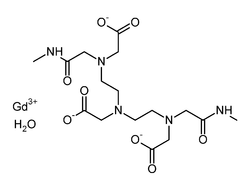Adverse effects
Gadodiamide is one of the main GBCA associated with nephrogenic systemic fibrosis (NSF), a toxic reaction occurring in some people with kidney problems. [5] No cases have been seen in people with normal kidney function. [6]
A 2015 study found gadolinium deposited in the brain tissue of people who had received gadodiamide. [7] Other studies using post-mortem mass spectrometry found most of the deposit remained at least 2 years after an injection and deposit also in individuals with no kidney issues.
In vitro studies found it to be neurotoxic. [8]
An Italian task force recommended that breastfeeding mothers precautionally avoid any contrast agent, such as gadodiamide, that has been associated with nephrogenic systemic fibrosis. [9]
Like other gadolinium-based contrast agents (GBCAs), gadodiamide may cause a range of adverse reactions. The most common include mild symptoms such as nausea, headache, or injection site discomfort. However, rare but serious reactions have been reported.
Hypersensitivity and anaphylaxis
Gadodiamide can cause severe allergic or hypersensitivity reactions, including anaphylaxis—a potentially life-threatening condition requiring immediate medical attention and treatment with epinephrine (adrenaline). Post-marketing surveillance and case studies have documented such events in patients who received gadodiamide. [10]
Data from the U.S. FDA Adverse Event Reporting System (FAERS) also list anaphylaxis and other hypersensitivity reactions among the reported adverse effects associated with gadodiamide. [11]
Patients with a known history of allergic reactions to contrast media or other drugs should inform their healthcare provider before undergoing imaging studies with gadodiamide. In high-risk individuals, premedication and pre-screening protocols may be considered to mitigate the risk of severe reactions.
This page is based on this
Wikipedia article Text is available under the
CC BY-SA 4.0 license; additional terms may apply.
Images, videos and audio are available under their respective licenses.

